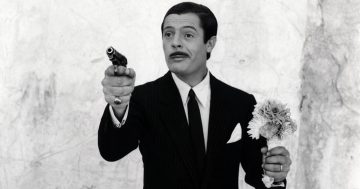The Golden Age of Hollywood
Film Art
We could make this publication thanks to small donations. How is 3 minutos de arte supported?
The Golden Age of Hollywood (Classic Hollywood Cinema)
The Golden Age of Hollywood is the era of “classic cinema,” which took place mainly in the 1930s and 1940s, although the 1950s can also be included. A glorious era that was born of a great crisis, as often happens.
The introduction of sound film (the first being The Jazz Singer, 1927) forced many studios to reinvent themselves and make large investments. And as it was an economically complicated period, most of them were left in a fragile position. And then came the Great Depression in 1929, which lasted throughout the 1930s. The small studios went bankrupt, and only eight major studios survived: RKO Pictures, Paramount, MGM, Fox, Warner Bros., Universal Pictures, Columbia Pictures, and United Artists. Here we could also include the special case of the Disney studios, which also produced great classics.
These studios made decisions that turned cinema into a real industry like so many others: the films, even if many of them are great milestones in the history of cinema, are real “products,” conceived with a well-defined system and a commercial logic. This is the so-called “studio system.”
The four fundamental characteristics that ruled those years in which the great classic films of history were produced are:
- Vertical integration. The studios became owners of the theaters to a large extent, ensuring the exhibition of their films. On the other hand, independent theaters were obliged to buy a block of films, (block booking), which guaranteed the studios the distribution and screening of unsuccessful films.
- Centralization of production. The creative processes were not in the hands of directors or screenwriters but of one or two general producers at the studios. They made all the decisions to turn the script (which they also chose) into a blockbuster.
- The star system. Each studio had its own group of megastars (as well as screenwriters and directors), with long-term contracts very convenient for the studios and almost suffocating for the stars. Those stars became more and more famous and helped studios succeed, but they did not earn accordingly
- Specialization of each studio. Each studio specialized in one or a couple of genres, which guaranteed better results. The interesting thing about this period is that most of the films did not have, as in other periods (mainly in the future), the “director’s hallmark,” but they did have the “studio’s hallmark.”
The films of this golden age did not seek to stand out for a “creative” way of telling stories, but their fundamental characteristics were very “classic,” very much to the taste of the majority: stories with solid plots, prototypical characters (well defined), unambiguous narratives, with a linear temporal order, and without things that can confuse. The attention, the delight of the viewer, and ultimately the success at the box office were not obtained with brilliant creative gadgets but with elementary and effective resources: good stories, spectacular productions, and stars in the main roles.
Why didn’t this golden era continue? There are three reasons for the decline of the studio system and the star system during the 1940s: the stars began to win their studios lawsuits that revoked those suffocating, almost “exploitative,” contracts to which they were subjected; also, the studios had to stop controlling exhibition (vertical integration) when the antitrust law went into effect. U.S. Finally, in the late 1940s, television started to dominate the industry, and it demanded many of the production resources possessed by the cinema; it also changed consumer habits. Television revolutionized culture, and, obviously, cinema could not isolate itself from this phenomenon. It was forced to evolve.
Image: Vivien Leigh and Clark Gable in Gone with the Wind (Victor Fleming, 1939)
Representative films:
King Kong (Merian C. Cooper and Ernest B. Schoedsack , 1931)
Snow White and the Seven Dwarfs (David Hand, 1937)
Stagecoach (John Ford, 1939)
Wuthering Heights (William Wyler, 1939)
Gone with the Wind (Victor Fleming, 1939)
The Wizard of Oz (Victor Fleming, 1939)
Citizen Kane (Orson Welles, 1941)
Casablanca (Michael Curtiz, 1942)
It’s a Wonderful Life (Frank Capra, 1946)
Sunset Boulevard (Billy Wilder, 1950)
Singin’ in the Rain (Stanley Donen, 1952)
Recommended links:
The Best American Movies in History according to the American Film Institute.
The First Comedy Film of the History of Cinema.
The Three Beginnings of Cinema.
Film d’auteur (Auteur cinema).
You can also find more material using the search engine.




0 Comments